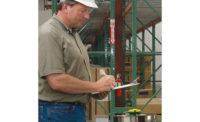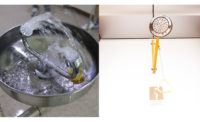
In order to be effective, emergency eyewash stations are required to be easy to reach and simple to operate by someone with injured eyes. Yet, it may seem surprising just how easy it is to hinder workers’ ability to rinse their eyes properly during an emergency.
Your facility is set up to operate smoothly and to meet applicable safety standards - both your company’s internal guidelines and those set by the American National Standards Institute (ANSI). When it comes to eyewash stations, it’s easy to install, maintain and use them properly - and as you’ll see, it’s equally easy to inhibit their use. Could your facility be making common mistakes that actually prevent workers from rinsing their eyes in case of emergency? Here is a look at some common pitfalls to the proper use of emergency eyewash systems, and the safety guidelines that should be followed instead.
1 - Do not place an emergency eyewash station behind a closed or locked door.
It may sound crazy, but this is a common workplace mistake. While the station may be used infrequently, remember that when it’s needed, someone’s vision is on the line - and every second counts. ANSI requires that eyewash be placed in an accessible, unobstructed location that requires no more than a ten second walk from the hazardous materials by everyone who works with or among these materials. Where strong acids or strong caustics are present, eyewash should be located immediately adjacent to the hazard.
2 - Do not hang the unit at an angle.
This can interfere with the proper flow of flushing fluid and may force an injured person to stand in an uncomfortable position to flush properly for the duration of his or her 15-minute required flush. And remember, some portable stations are gravity-fed, so a unit will not work if it is placed on the ground or table top. Be sure nozzles are at the correct height and are hung level. ANSI requires that eyewash stations be positioned with the flushing fluid nozzles placed between 33 and 45 inches from the surface on which the user stands. This helps ensure that both eyes are flushed simultaneously and that the station can be used hands-free by the operator, so he or she can hold both eyes open throughout the flushing period.
3 - Avoid storing anything underneath or in front of an eyewash unit.
This can block an injured worker’s ability to reach or stand comfortably at the station. If you’re looking for a place to store that extra piece of machinery, don’t consider a location around the eyewash station. In order to meet ANSI requirements, the eyewash must be located a minimum of six inches from the wall or nearest obstruction, and the path of travel to the unit must remain free of obstructions that inhibit its immediate use.
4 - Do not allow the flushing fluid to become too hot or too cold.
Storing eyewash in extremely hot or cold environments can cause flushing fluid’s temperature to rise or fall outside of ANSI’s stated standard for tepid water. Flushing eyes with scalding or ice-cold water can cause further damage to an already compromised eye. In hot environments where the unit is exposed to direct sun, for example, try moving the unit into shade or using reflective jackets or dust covers to protect it. And, per ANSI, where the possibility of freezing exists, eyewash should be protected from freezing, or freeze-protected equipment should be installed. According to ANSI, in circumstances where a chemical reaction is accelerated by the flushing fluid temperature, a facility’s safety or health advisor should be consulted for the optimum temperature for each application.
5 - Avoid mistakes when mixing flushing fluid.
ANSI requires that the unit be filled with flushing fluid or the pre-packaged fluid provided by the manufacturer. Always prepare fluid according to manufacturers’ instructions. Keep in mind that concentrates require water to be added, and be particularly careful to mix flushing fluids using the proper ratio of liquids. If mixed improperly, the fluid may be too weak to be effective or too strong and cause further injury.
6 - Clean, disinfect, rinse and completely dry the unit after each activation.
This includes hoses, nozzles and nozzle covers (this does not apply to sealed-fluid cartridges). Any lingering cleaning chemicals or particles may harm the next user’s eyes. When the wrong chemicals (for instance, chlorine and concentrate) mix, the fluid may turn brown or another color, and colored fluid is never usable. If flushing fluid is colored, check the chemicals to make sure the right ones are being used, then clean and dry the station thoroughly again and refill it so that the fluid is clear. ANSI states that eyewash should be maintained per the manufacturer’s instructions, which shall be readily accessible to maintenance and inspection personnel.
7 - Do not place a plastic bag or other makeshift cover over the unit to keep dust or particles out.
These hinder an injured person’s ability to operate the eyewash unit. Instead use covers that are designed specifically for your station – this ensures the station can be operated in accordance with ANSI’s requirement that it can be activated in a single motion and the flow be started in one second or less. While ANSI requires that nozzles and flushing fluid units be protected from airborne contaminants, the cover’s removal must not require a separate motion to activate the unit.
8 - Avoid using expired flushing fluid.
Like any standing water, eyewash fluid can grow bacteria that may be harmful to eyes. Be sure that someone is responsible for checking stations’ expiration dates and refilling/replacing them according to the manufacturer’s guidelines. Generally, fluids last three to six months for tank-style stations and two to three years for sealed-fluid cartridges and bottles. Per ANSI, self-contained stations must be visually checked monthly to determine whether flushing fluid is outdated and needs to be changed or has been tampered with and must be replaced.
9 - Carefully follow the manufacturer's installation instructions.
Assembly may seem self-explanatory, but you wouldn’t build a bicycle without first consulting the manual. Stations vary and have precise installation instructions to ensure proper performance, including installation height, the rate of fluid flow, required spray pattern, and much more. ANSI requires that units be set up according to the manufacturer’s instructions.
10 - Do not alter or tamper with the unit.
Again, the manufacturer’s instructions are the only ones that should be followed. Do not try to re-route hoses, change nozzles or otherwise compromise the station’s performance. One key to success here is training and communication: if everyone understands what the unit is for and how it is to be used and maintained, this will quell the natural curiosity of workers who may otherwise become interested in tinkering with the unit to see how it works – which could render the unit useless.
When a worker cannot rinse his eyes promptly following an eye injury, his vision may become impaired or lost as a result. Because our eyesight is an invaluable window into our world, it is imperative that every emergency eyewash station meets the required safety standards to best protect workers. By understanding how to use emergency eyewash properly – and the pitfalls to avoid – your facility can ensure greater workplace eye safety, and that’s a clear benefit everyone can see.





